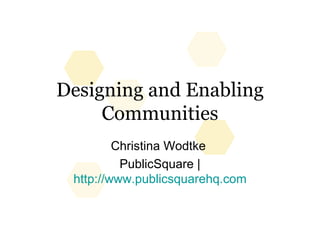
Designing Communities101507 1192637120231725 1
- 1. Designing and Enabling Communities Christina Wodtke PublicSquare | http://www.publicsquarehq.com
- 2. Me?
- 3. You What do you want?
- 5. What is community, really?
- 8. David Armano: graphic Tim O’Reilly quote and list
- 9. Virtual Community A virtual space supported by computer-based information technology, centered upon communication and interaction of participants to generate member-driven content , resulting in relationships being built up. (Lee & Vogel, 2003)
- 10. Webb/Butterfield/Smith Model Based on Matt Webb , Stewart Butterfield ’s and Gene Smith’s writings
- 11. The Social Web is a digital space where data about human interactions is as important as other data types for providing value Community is when those humans care about each other.
- 12. Where is all this happening?
- 16. When do I have to do something about all this?
- 17. When? Are you waiting for Web 4.0?
- 18. Credits: Tim O’Reilly’s The Facebook Application Platform and compete, a a site for web metrics
- 20. Now No time like the present
- 21. Why?
- 22. Trebor Scholz http://collectivate.net
- 23. 8 days after a video was posted showing how to pick the lock in 30 seconds using a pen Kryptonite recalled 380,000 locks
- 24. Your users have something to tell you. If you don’t give them a way to communicate, they will find one. Trebor Scholz http://collectivate.net
- 28. How?
- 31. The Social Web is built here, from love and esteem
- 32. O’Reilly Report on Facebook The Facebook Application Platform
- 33. Motivation for hours (and hours and hours) of work
- 36. Reciprocity
- 37. What's the motivation of behind these people actually interacting and participating? … people want to share with the community what they believe to be important …. and they want to see their name in lights. They want to see their little icon on the front page, their username on the front page, so other people can see it. Reputation
- 38. Increased sense of efficacy
- 39. Attachment to and need of a group
- 43. "The debate keeps getting framed as if the only true alternative were to opt out of media altogether and live in the woods, eating acorns and lizards and reading only books published on recycled paper by small alternative presses" Convergence Culture , Henry Jenkins Tim O’Reilly’s Hippies.
- 44. Strategize a community exercise Presence Conversations Sharing Relationships Groups Reputation Identity
- 45. “ Strategy is knowing what not to do” Michael Porter
- 46. Break... please be back at 2:45 pm...
- 47. Webb/Butterfield/Smith Model Based on Matt Webb , Stewart Butterfield ’s and Gene Smith’s writings
- 48. 1.) If you were going to build a piece of social software to support large and long-lived groups, what would you design for? The first thing you would design for is handles the user can invest in. Clay Shirky, A Group Is Its Own Worst Enemy http://shirky.com/writings/group_enemy.html
- 50. Identity is Context Based Facebook- Personal LinkedIN - Professional
- 51. Presence
- 54. 2.) Second, you have to design a way for there to be members in good standing. Have to design some way in which good works get recognized. The minimal way is, posts appear with identity. You can do more sophisticated things like having formal karma or "member since."
- 55. Reputation
- 56. Relationships
- 57. 3.) Three, you need barriers to participation. This is one of the things that killed Usenet. You have to have some cost to either join or participate , if not at the lowest level, then at higher levels. … anyone can read Slashdot, anonymous cowards can post, non-anonymous cowards can post with a higher rating. But to moderate, you really have to have been around for a while. Missing block?
- 61. Conversations
- 63. 4.) And, finally, you have to find a way to spare the group from scale. Scale alone kills conversations, because conversations require dense two-way conversations. [Dunbar] found that the MAXIMUM number of people that a person could keep up with socially at any given time, gossip maintenance, was 150. This doesn't mean that people don't have 150 people in their social network, but that they only keep tabs on 150 people max at any given point.
- 64. Sharing
- 65. Presence Conversations Sharing Relationships Groups Reputation Identity Self Community Activity Rules & Repercussions Purpose/ Passion? Co-Creation? Planning? Caretakers? Collectively Rate? Publish?
- 66. Rules & Repercussions Purpose/ Passion? Co-Creation? Planning? Caretakers? Collectively Rate? Publish?
- 67. Design a community exercise Presence Conversations Sharing Relationships Groups Reputation Identity
- 69. Does Software Matter? Robin Miller , Cofounder of Slahdot Joel Spolsky , Joel on Software
- 70. Probably not
- 71. Your take? Christina Wodtke http://www.slideshare.net/cwodtke http://www.publicquarehq.com